The Thermal Imbalances Recorded at the NE Rift during the 2012 Explosive Activity at the South East Cone (Mt. Etna, Italy)
Abstract
:1. Introduction
2. The Volcanic Activity on Mt. Etna Leading to the Paroxysmal Episodes of 2012
3. Materials and Methods
3.1. Data Collection
3.2. Method for the Depth Limit of the Conductive Layer (Z1)
3.3. Heat Flux of the Steam-Heated Ground (SHSFlux)
4. Results
4.1. Overall Variations of Z1 and of SHSFlux
4.2. Time Evolution of SHSFlux near the End of the Eruptive Activity
5. Discussion
6. Conclusions
Author Contributions
Funding
Institutional Review Board Statement
Informed Consent Statement
Data Availability Statement
Acknowledgments
Conflicts of Interest
References
- D’alessandro, W.; Giammanco, S.; Parello, F.; Valenza, M. CO2 output and δ13C (CO2) from Mount Etna as indicators of degassing of shallow asthenosphere. Bull. Volcanol. 1997, 58, 455–458. [Google Scholar] [CrossRef]
- Chiodini, G.; Frondini, F.; Cardellini, C.; Granieri, D.; Marini, L.; Ventura, G. CO2 degassing and energy release at Solfatara volcano, Campi Flegrei, Italy. J. Geophys. Res. Solid Earth 2001, 106, 16213–16221. [Google Scholar] [CrossRef]
- Chiodini, G.; Granieri, D.; Avino, R.; Caliro, S.; Costa, A.; Werner, C. Carbon dioxide diffuse degassing and estimation of heat release from volcanic and hydrothermal systems. J. Geophys. Res. 2005, 110, B08204. [Google Scholar] [CrossRef]
- Cannata, A.; Giudice, G.; Gurrieri, S.; Montalto, P.; Alparone, S.; Di Grazia, G.; Favara, R.; Gresta, S.; Liuzzo, M. Relationship between soil CO2 flux and volcanic tremor at Mt Etna: Implications for magma dynamics. Environ. Earth Sci. 2010, 61, 477–489. [Google Scholar] [CrossRef]
- Cannata, A.; Diliberto, I.S.; Alparone, S.; Gambino, S.; Gresta, S.; Liotta, M.; Madonia, P.; Milluzzo, V.; Aliotta, M.; Montalto, P. Multiparametric approach in investigating hydrothermal systems: The case of study of Vulcano (Aeolian islands Italy). Pure Appl. Geophys. 2012, 169, 167–182. [Google Scholar] [CrossRef]
- Liuzzo, M.; Gurrieri, S.; Giudice, G.; Giuffrida, G. Ten years of soil CO2 continuous monitoring on Mt. Etna: Exploring the relationship between processes of soil degassing and volcanic activity. Geochem. Geophys. Geosyst. 2013, 14, 2886–2899. [Google Scholar] [CrossRef]
- Madonia, P.; Rizzo, A.; Diliberto, I.S.; Favara, R. Continuous monitoring of fumarole temperatures at Mount Etna (Italy). J. Volcanol. Geotherm. Res. 2013, 257, 12–20. [Google Scholar] [CrossRef]
- Mattia, M.; Bruno, V.; Caltabiano, T.; Cannata, A.; Cannavo, F.; D’alessandro, W.; Di Grazia, G.; Federico, C.; Giammanco, S.; La Spina, A.; et al. A comprehensive interpretative model of slow slip events on Mt. Etna’s eastern flank. Geochem. Geophys. Geosyst. 2015, 16, 635–658. [Google Scholar] [CrossRef]
- Paonita, A.; Caracausi, A.; Martelli, M.; Rizzo, A.L. Temporal variations of helium isotopes in volcanic gases quantify pre-eruptive refill and pressurization in magma reservoirs: The Mount Etna case. Geology 2016, 44, 499–502. [Google Scholar] [CrossRef]
- Epiard, M.; Avard, G.; De Moor, J.M.; Martínez Cruz, M.; Barrantes Castillo, G.; Bakkar, H. Relationship between Diffuse CO2 Degassing and Volcanic Activity. Case Study of the Poás, Irazú, and Turrialba Volcanoes, Costa Rica. Front. Earth Sci. 2017, 5, 71. [Google Scholar] [CrossRef]
- Camarda, M.; De Gregorio, S.; Capasso, G.; Di Martino, R.M.R.; Gurrieri, S.; Prano, V. The monitoring of natural soil CO2 emissions: Issues and perspectives. Earth-Sci. Rev. 2019, 198, 102928. [Google Scholar] [CrossRef]
- Girona, T.; Realmuto, V.; Lundgren, P. Large-scale thermal unrest of volcanoes for years prior to eruption. Nat. Geosci. 2021, 14, 238–241. [Google Scholar] [CrossRef]
- Mannini, S.; Harris, A.J.L.; Jessop, D.E.; Chevrel, M.O.; Ramsey, M.S. Combining Ground- and ASTER-Based Thermal Measurements to Constrain Fumarole Field Heat Budgets: The Case of Vulcano Fossa 2000–2019. Geophys. Res. Lett. 2019, 46, 11868–11877. [Google Scholar] [CrossRef]
- Girona, T.; Realmuto, V. Satellite-based thermal precursors of volcanic eruptions. In Abstracts Volume of the International Meeting “Cities on Volcanoes 10”, 2–7 September 2018, Napoli, Italy; Miscellanea INGV: Napoli, Italy, 2018; Volume 43, p. 758. [Google Scholar]
- Kotsarenko, A.; Yutsis, V.; Grimalsky, V.; Koshevaya, S.; Kotsarenko, Y. Anomalous temperature regimen in the near surface soil layer of Tlamacas hill and its relation to activity of Popocatépetl Volcano, Mexico, BSGF. Earth Sci. Bull. 2020, 191, 3. [Google Scholar] [CrossRef]
- Inguaggiato, S.; Vita, F.; Diliberto, I.S.; Mazot, A.; Calderone, L.; Mastrolia, A.; Corrao, M. The Extensive Parameters as a Tool to Monitoring the Volcanic Activity: The Case Study of Vulcano Island (Italy). Remote Sens. 2022, 14, 1283. [Google Scholar] [CrossRef]
- Diliberto, I.S. Long-term monitoring on a closed-conduit volcano: A 25 year long time-series of temperatures recorded at La Fossa cone (Vulcano Island). J. Volcanol. Geotherm. Res. 2017, 346, 151–160. [Google Scholar] [CrossRef]
- Harris, A.J.L.; Butterworth, A.L.; Carlton, R.W.; Downey, I.; Miller, P.; Navarro, P.; Rothery, D.A. Low-cost volcano surveillance from space: Case studies from Etna, Krafla, Cerro Negro, Fogo, Lascar and Erebus. Bull. Volcanol. 1997, 59, 49. [Google Scholar] [CrossRef]
- Harris, A.J.L.; Lodato, L.; Dehn, J.; Spampinato, L. Thermal characterization of the Vulcano fumarole field. Bull. Volcanol. 2009, 71, 441–458. [Google Scholar] [CrossRef]
- Diliberto, I.S. Time series analysis of high temperature fumaroles monitored on the island of Vulcano (Aeolian Archipelago, Italy). J. Volcanol. Geotherm. Res. 2013, 264, 150–163. [Google Scholar] [CrossRef]
- Diliberto, I.S.; Gagliano Candela, E.; Morici, S.; Pecoraino, G.; Bellomo, S.; Bitetto, M.; Longo, M. Changes in heat released by hydrothermal circulation monitored during an eruptive cycle at Mt. Etna (Italy). Bull. Volcanol. 2018, 80, 31. [Google Scholar] [CrossRef]
- Aubert, M.; Diliberto, I.S.; Finizola, A.; Chebli, Y. Double origin of hydrothermal convective flux variations in the Fossa of Vulcano (Italy). Bull. Volcanol. 2008, 70, 743–751. [Google Scholar] [CrossRef]
- Ganci, G.; Cappello, A.; Bilotta, G.; Corradino, C.; Del Negro, C. Satellite-Based Reconstruction of the Volcanic Deposits during the December 2015 Etna Eruption. Data 2019, 4, 120. [Google Scholar] [CrossRef] [Green Version]
- Girona, T.; Costa, F.; Newhall, C.; Taisne, B. On depressurization of volcanic magma reservoirs by passive degassing. J. Geophys. Res. Solid Earth 2014, 119, 8667–8687. [Google Scholar] [CrossRef]
- Branca, S.; Del Carlo, P. Types of eruptions of Etna volcano AD1670–2003:implications for short-term eruptive behavior. Bull. Volcanol. 2005, 67, 732–742. [Google Scholar] [CrossRef]
- Giammanco, S.; Melián, G.; Neri, M.; Hernández, P.A.; Sortino, F.; Barrancos, J.; López, M.; Pecoraino, G.; Perez, N.M. Active tectonic features and structural dynamics of the summit area of Mt. Etna (Italy) revealed by soil CO2 and soil temperature surveying. J. Volcanol. Geotherm. Res. 2016, 311, 79–98. [Google Scholar] [CrossRef]
- Behncke, B.; Branca, S.; Corsaro, R.A.; De Beni, E.; Miraglia, L.; Proietti, C. The 2011–2012 summit activity of Mount Etna: Birth, growth and products of the new SE crater. J. Volcanol. Geotherm. Res. 2014, 270, 10–21. [Google Scholar] [CrossRef]
- Viccaro, M.; Garozzo, I.; Cannata, A.; Di Grazia, G.; Gresta, S. Gas burst vs. gas-rich magma recharge: A multidisciplinary study to reveal factors controlling triggering of the recent paroxysmal eruptions at Mt. Etna. J. Volcanol. Geotherm. Res. 2014, 278–279, 1–13. [Google Scholar] [CrossRef]
- Carbone, D.; Zuccarello, L.; Messina, A.; Scollo, S.; Rymer, H. Balancing bulk gas accumulation and gas output before and during lava fountaining episodes at Mt. Etna. Sci. Rep. 2015, 5, 18049. [Google Scholar] [CrossRef] [Green Version]
- Bombrun, M.; Spampinato, L.; Harris, A.; Barra, V.; Caltabiano, T. On the transition from strombolian to fountaining activity: A thermal energy-based driver. Bull. Volcanol. 2016, 78, 15. [Google Scholar] [CrossRef]
- Calvari, S.; Cannavò, F.; Bonaccorso, A.; Spampinato, L.; Pellegrino, A.G. Paroxysmal Explosions, Lava Fountains and Ash Plumes at Etna Volcano: Eruptive Processes and Hazard Implications. Front. Earth Sci. 2018, 6, 107. [Google Scholar] [CrossRef]
- Spampinato, L.; Calvari, S.; Oppenheimer, C.; Lodato, L. Shallow magma transport for the 2002–3 Mt. Etna eruption inferred from thermal infrared surveys. J. Volcanol. Geotherm. Res. 2008, 177, 301–312. [Google Scholar] [CrossRef]
- Ruch, J.; Pepe, S.; Casu, F.; Solaro, G.; Pepe, A.; Acocella, V.; Neri, M.; Sansosti, E. Seismo-tectonic behavior of the Pernicana Fault System (Mt Etna): A gauge for volcano flank instability? Geophys. Res. Lett. Solid Earth 2013, 118, 4398–4409. [Google Scholar] [CrossRef]
- Behncke, B.; Neri, M. Cycles and trends in the recent eruptive behaviour of Mount Etna (Italy). Can. J. Earth Sci. 2003, 40, 31. [Google Scholar] [CrossRef]
- Liotta, M.; Paonita, A.; Caracausi, A.; Martelli, M.; Rizzo, A.; Favara, R. Hydrothermal processes governing the geochemistry of the crater fumaroles at Mount Etna volcano (Italy). Chem. Geol. 2010, 278, 92–104. [Google Scholar] [CrossRef]
- Maucourant, S.; Giammanco, S.; Greco, F.; Dorizon, S.; Del Negro, C. Geophysical and geochemical methods applied to investigate fissure-related hydrothermal systems on the summit area of Mt. Etna volcano (Italy). J. Volcanol. Geotherm. Res. 2014, 280, 111125. [Google Scholar] [CrossRef]
- Alparone, S.; Andronico, D.; Giammanco, S.; Lodato, L. A multidisciplinary approach to detect active pathways for magma migration and eruption at Mt. Etna (Sicily, Italy) before the 2001 and 2002–2003 eruptions. J. Volcanol. Geotherm. Res. 2014, 136, 121–140. [Google Scholar] [CrossRef]
- Calvari, S.; Salerno, G.G.; Spampinato, L.; Gouhier, M.; La Spina, A.; Pecora, E.; Harris, A.J.L.; Labazuy, P.; Biale, E.; Boschi, E. An unloading foam model to constrain Etna’s 11–13 January 2011 lava fountaining episode. J. Geophys. Res. Solid Earth 2011, 116, B11207. [Google Scholar] [CrossRef]
- Tabbagh, A.; Trezeguet, D. Determination of sensible heat flux in volcanic areas from ground temperature measurements along vertical profiles: The case study of Mount Etna Sicily, Italy. J. Geophys. Res. 1987, 92, 3635–3644. [Google Scholar] [CrossRef]
- Aubert, M. Practical evaluation of steady heat discharge from dormant active volcanoes: Case study of Vulcarolo fissure Mount Etna Italy. J. Volcanol. Geotherm. Res. 1999, 92, 413–429. [Google Scholar] [CrossRef]
- Giammanco, S.; Inguaggiato, S.; Valenza, M. Soil and fumarole gases of Mount Etna: Geochemistry and relations with volcanic activity. J. Volcanol. Geotherm. Res. 1998, 81, 297–310. [Google Scholar] [CrossRef]
- Inguaggiato, S.; Diliberto, I.S.; Federico, C.; Paonita, A.; Vita, F. Review of the evolution of geochemical monitoring, networks and methodologies applied to the volcanoes of the Aeolian Arc (Italy). Earth-Sci. Rev. 2018, 176, 241–276. [Google Scholar] [CrossRef]
- Gaudin, D.; Finizola, A.; Delcher, E.; Beauducel, F.; Allemand, P.; Delacourt, C.; Brothelande, E.; Peltier, A.; Di Gangi, F. Influence of rainfalls on heat and steam fluxes of fumarolic zones: Six months records along the Ty fault (Soufrière of Guadeloupe, Lesser Antilles). J. Volcanol. Geotherm. Res. 2015, 302, 273–285. [Google Scholar] [CrossRef] [Green Version]
- Moschella, S.; Cannata, A.; Di Grazia, G.; Gresta, S. Insights into Lava Fountain Eruptions at Mt. Etna By Improved Source Location of the Volcanic Tremor. Ann. Geophys. 2018, 61, VO446. [Google Scholar] [CrossRef]
- De Beni, E.; Behncke, B.; Branca, S.; Nicolosi, I.; Carluccio, R.; D’Aiello Caracciolo, F.; Chiappini, M. The continuing story of Etna’s New Southeast Crater (2012–2014): Evolution and volume calculations based on field surveys and aerophotogrammetry. J. Volcanol. Geotherm. Res. 2015, 303, 175–186. [Google Scholar] [CrossRef]
- Patanè, D.; Aiuppa, A.; Aloisi, M.; Behncke, B.; Cannata, A.; Coltelli, M.; Di Grazia, G.; Gambino, S.; Gurrieri, S.; Mattia, M.; et al. Insights into magma and fluid transfer at Mount Etna by a multiparametric approach: A model of the events leading to the 2011 eruptive cycle. J. Geophys. Res. 2013, 118, 3519–3539. [Google Scholar] [CrossRef]
- Granieri, D.; Carapezza, M.L.; Chiodini, G.; Avino, R.; Caliro, S.; Ranaldi, M.; Tarchini, L. Correlated increase in CO2 fumarolic content and diffuse emission from La Fossa crater (Vulcano, Italy): Evidence of volcanic unrest or increasing gas release from a stationary deep magma body? Geophys. Res. Lett. 2006, 33, L13316. [Google Scholar] [CrossRef]
- Andronico, D.; Behncke, B.; De Beni, E.; Cristaldi, A.; Scollo, S.; Lopez, M.; Lo Castro, M.D. Magma Budget from Lava and Tephra Volumes Erupted during the 25–26 October 2013 Lava Fountain at Mt Etna. Front. Earth Sci. 2018, 6, 116. [Google Scholar] [CrossRef]
- Huppert, H.E.; Woods, A.W. The role of volatiles in magma chamber dynamics. Nature 2002, 420, 493–495. [Google Scholar] [CrossRef]
- Xu, T.; Pruess, K. Modeling multiphase non-isothermal fluid flow and reactive geochemical transport in variably saturated fractured rocks: 1. Methodology. Am. J. Sci. 2001, 301, 16–33. [Google Scholar] [CrossRef] [Green Version]
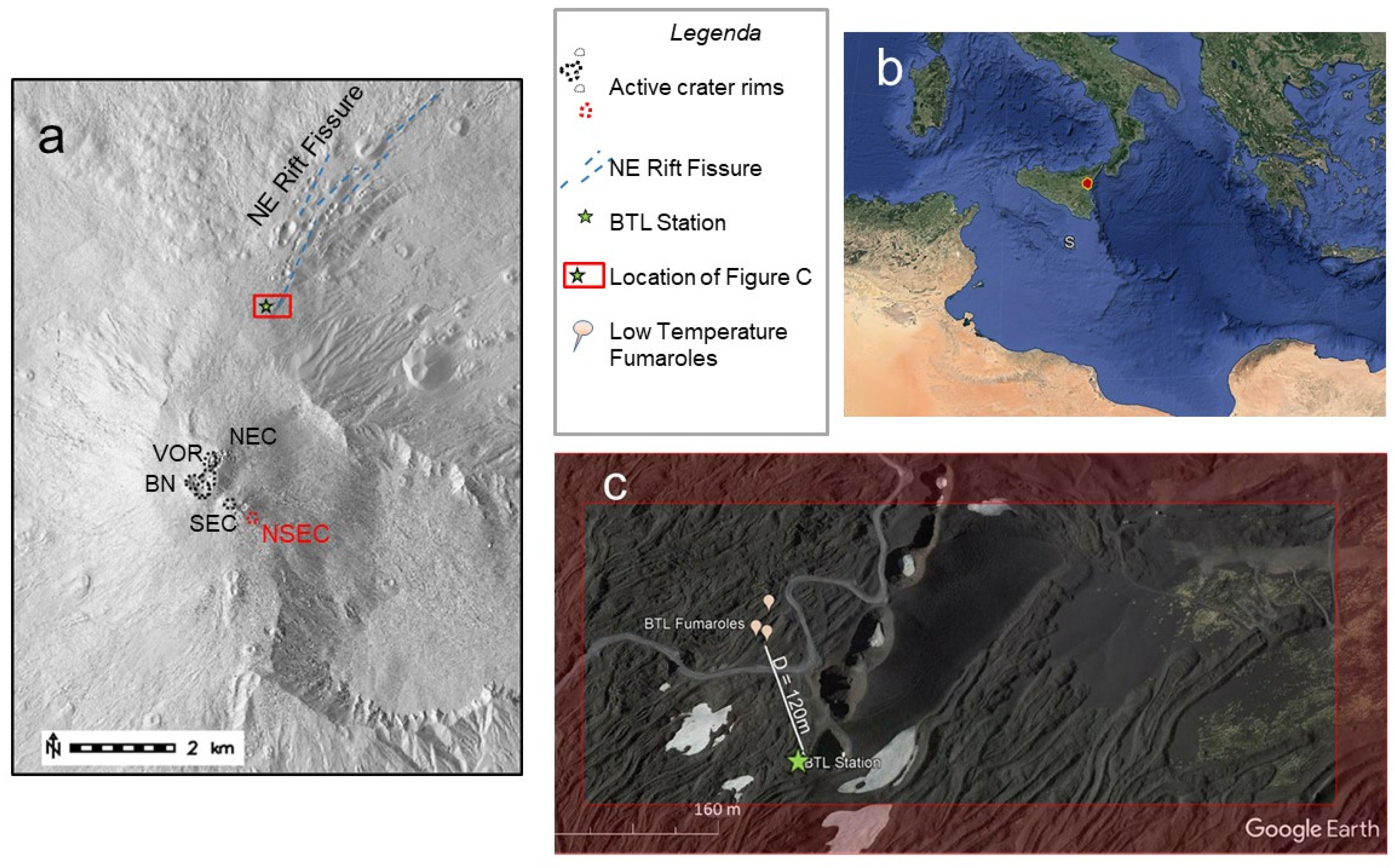
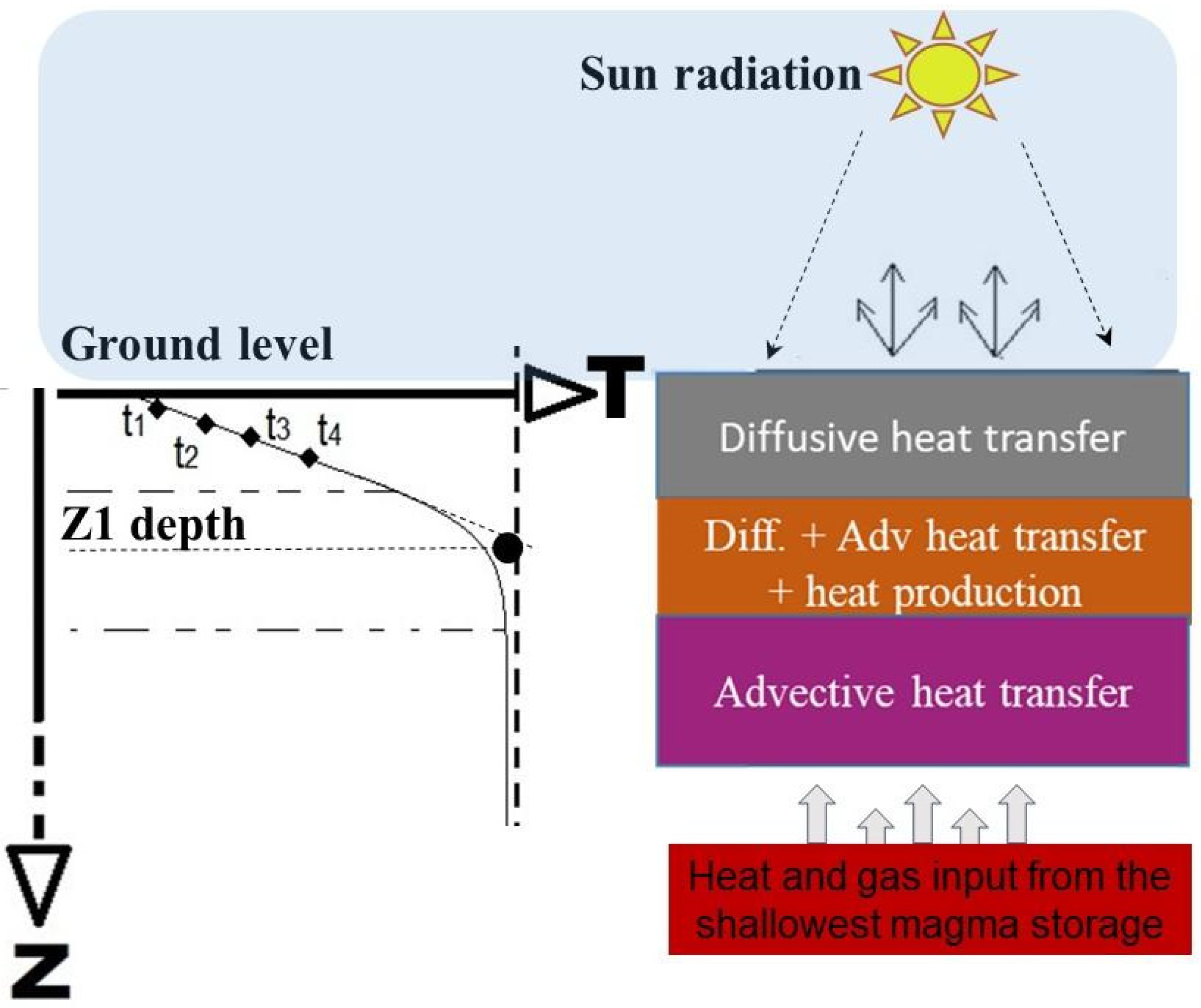
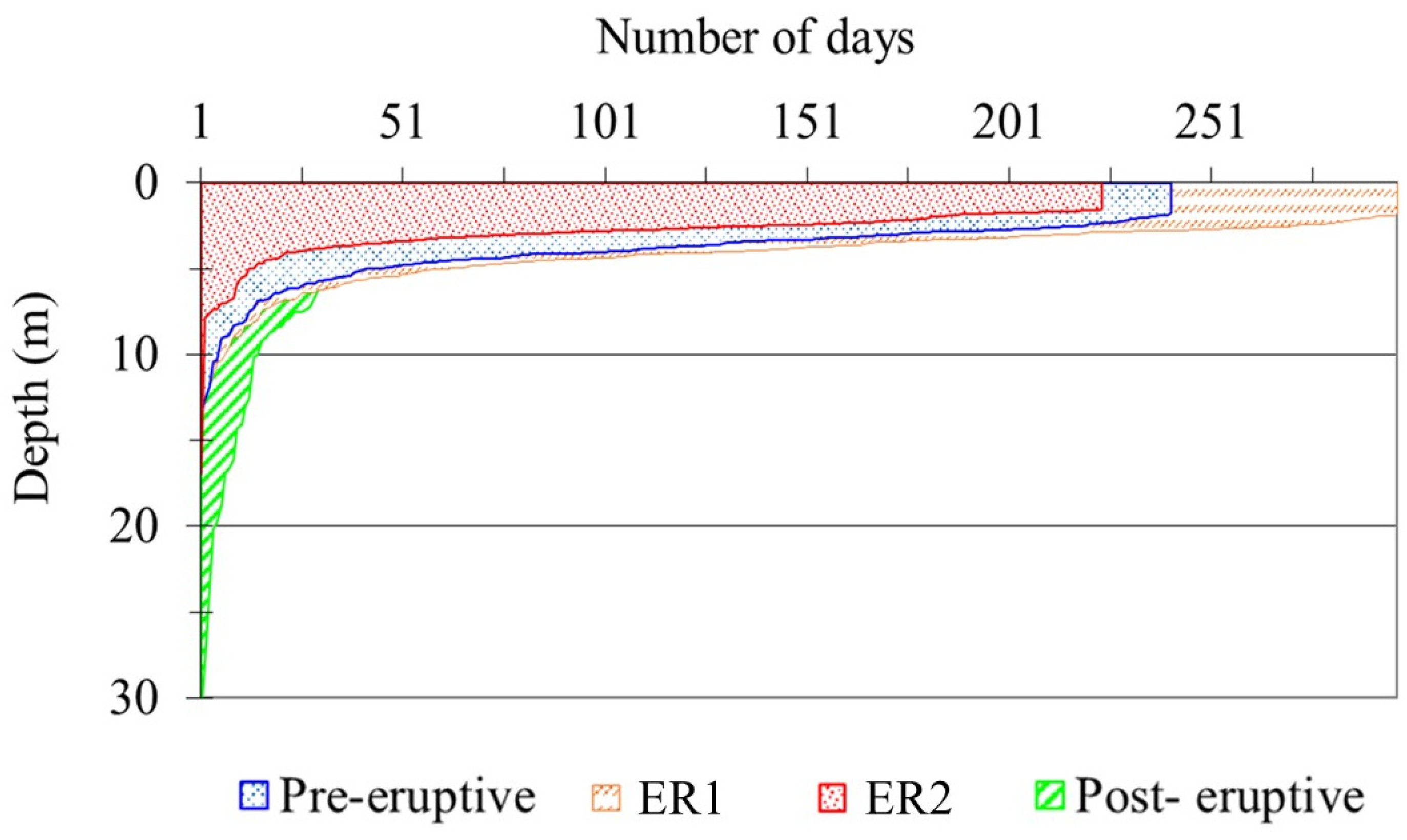
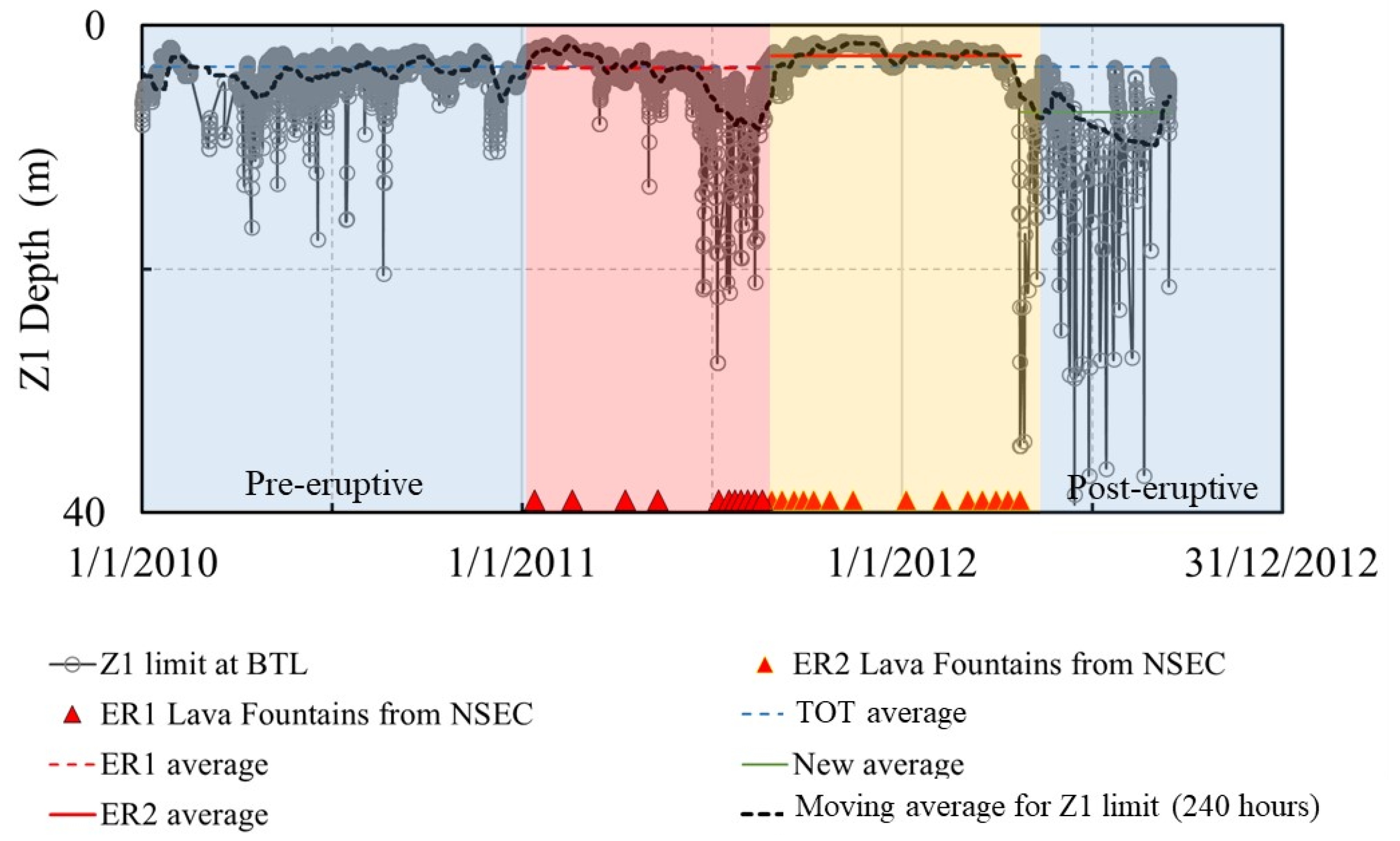
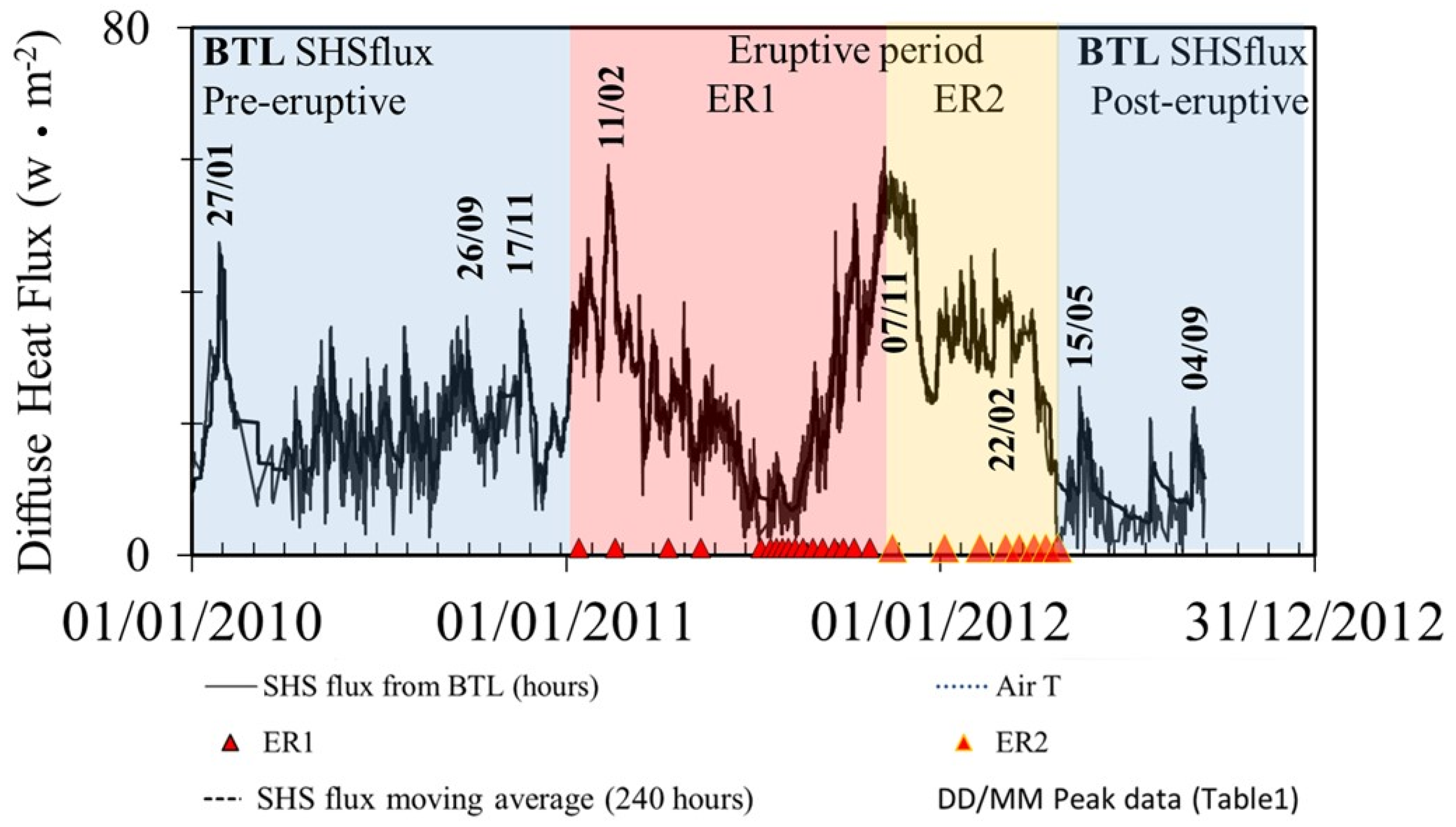
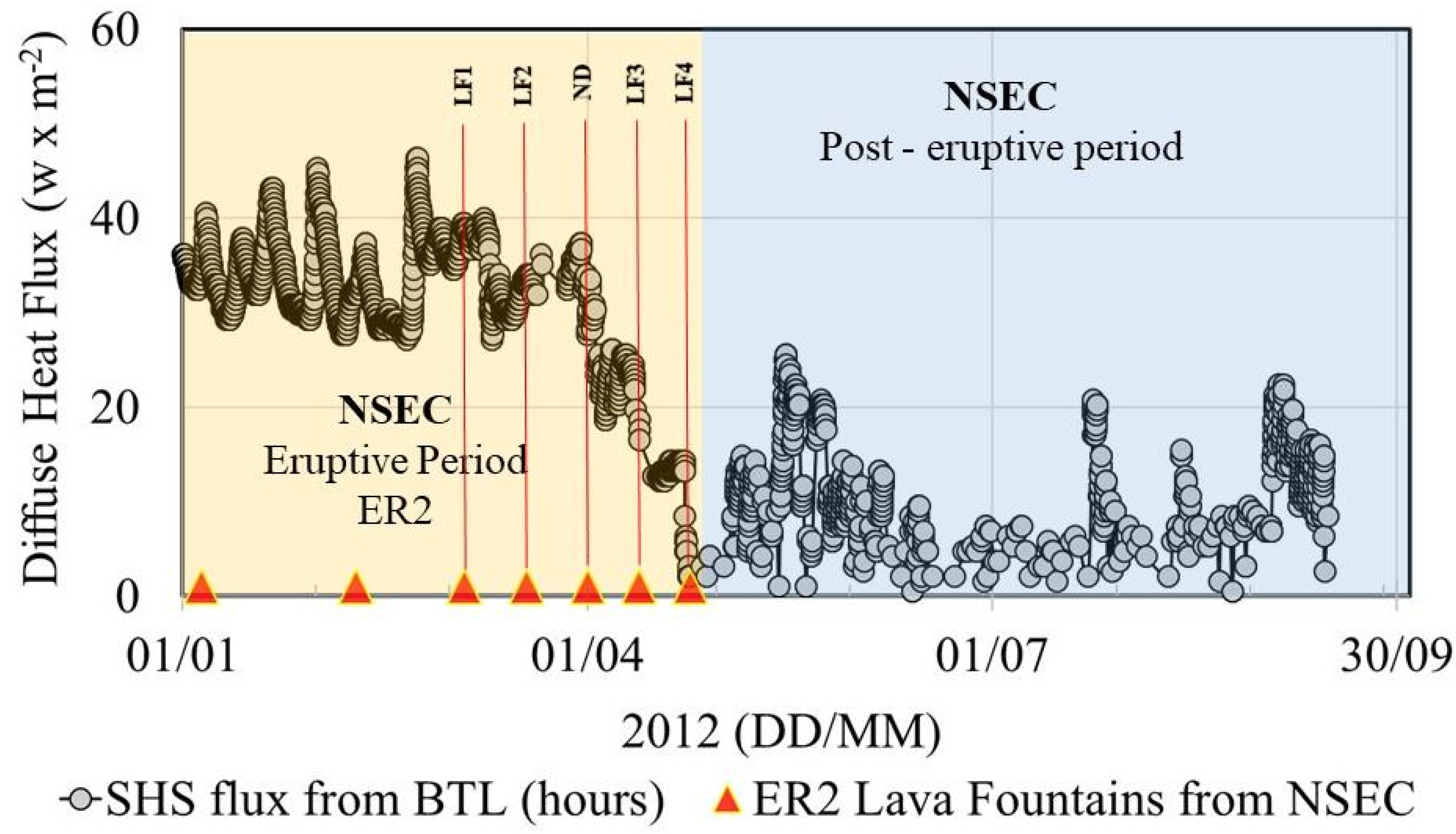
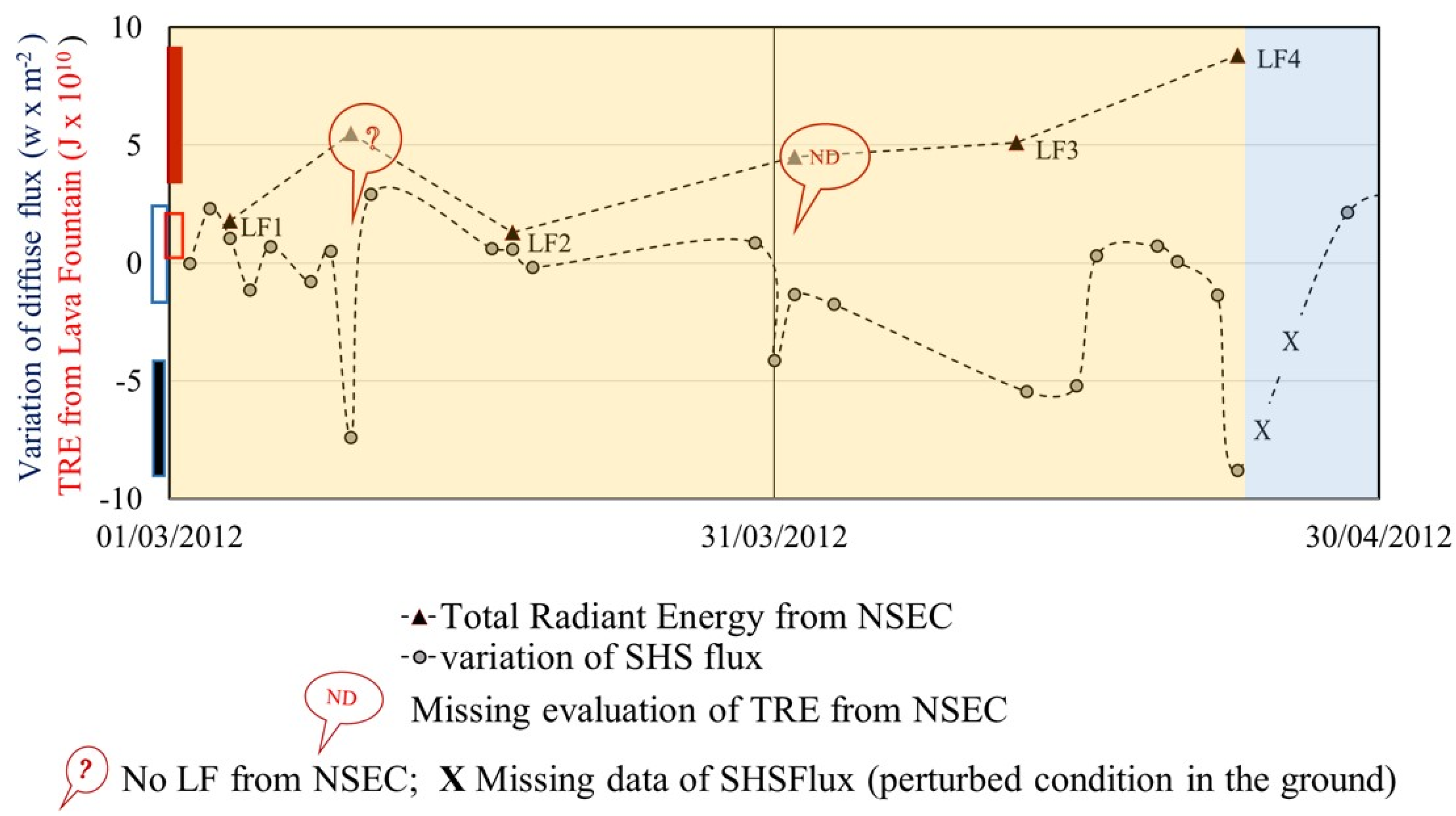
| SHS Peak (Figure 5) N° | Data Maximum Value (DD/MM/YY hh.mm) | SHS Flux (Hourly Value) Watt × m−2 | SHS Flux (Monthly Average) Watt × m−2 |
|---|---|---|---|
| 1 | 27/01/2010 19.43 | 37.55 | 22 |
| 2 | 26/09/2010 03.00 | 35.73 | 25 |
| 3 | 17/11/2010 14.00 | 29.44 | 22 |
| 4 | 11/02/2011 03.00 | 46.93 | 32 |
| 5 | 07/11/2011 12.00 | 48.64 | 43 |
| 6 | 22/02/2012 11.00 | 45.86 | 27 |
| 7 | 15/05/2012 11.00 | 25.60 | 12 |
| 8 | 04/09/2012 12.00 | 22.40 | 14 |
| NSECN ° of Lava Fountain a | Date of the Symbols in Figure 6 (DD/MM/YY) | Start of LF (GMT) b | End of LF (GMT) b | NSEC Total Radiant Energy (J × 1010) c | NER Variation of SHS Flux (W × m-2) a |
|---|---|---|---|---|---|
| 0 | 2/3/12 | - | - | 0 | −0.03 |
| 0 | 3/3/12 | - | - | 0 | 2.3 |
| 1 | 4/3/12 | 7:30 | 9:32 | 1.8 | 1.05 |
| ? | 5/3; 11/03 | - | - | - | −1 −7.9 |
| 0 | 6; 8; 9; 11/3/12 | - | - | - | >0.7 |
| 2 | 18/3/12 | 7:15 | 9:58 | 1.3 | 0.58 |
| 0 | 30/03/12 | - | - | 0 | 0.86 |
| 0 | 31/03/12 | - | - | −4.13 | |
| ND | 1/04/12 | 2:00 | 3:30 | ND | −1.76 |
| 3 | 12/04/12 | 14:10 | 15:20 | 5.1 | −5.46 |
| 0 | 16; 19; 22/4/12 | - | - | 0 | −1.38 0.71 |
| 4 | 23/4/12 | 1:30 | 2:15 | 8.8 | −8.78 |
| 0 | 28/4/12 | - | - | 0 | 2.14 |
Publisher’s Note: MDPI stays neutral with regard to jurisdictional claims in published maps and institutional affiliations. |
© 2022 by the authors. Licensee MDPI, Basel, Switzerland. This article is an open access article distributed under the terms and conditions of the Creative Commons Attribution (CC BY) license (https://creativecommons.org/licenses/by/4.0/).
Share and Cite
Diliberto, I.S.; Gennaro, E. The Thermal Imbalances Recorded at the NE Rift during the 2012 Explosive Activity at the South East Cone (Mt. Etna, Italy). Appl. Sci. 2022, 12, 4471. https://doi.org/10.3390/app12094471
Diliberto IS, Gennaro E. The Thermal Imbalances Recorded at the NE Rift during the 2012 Explosive Activity at the South East Cone (Mt. Etna, Italy). Applied Sciences. 2022; 12(9):4471. https://doi.org/10.3390/app12094471
Chicago/Turabian StyleDiliberto, Iole Serena, and Emanuela Gennaro. 2022. "The Thermal Imbalances Recorded at the NE Rift during the 2012 Explosive Activity at the South East Cone (Mt. Etna, Italy)" Applied Sciences 12, no. 9: 4471. https://doi.org/10.3390/app12094471
APA StyleDiliberto, I. S., & Gennaro, E. (2022). The Thermal Imbalances Recorded at the NE Rift during the 2012 Explosive Activity at the South East Cone (Mt. Etna, Italy). Applied Sciences, 12(9), 4471. https://doi.org/10.3390/app12094471






